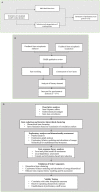Development and Initial Validation of the Duke Misophonia Questionnaire
- PMID: 34659024
- PMCID: PMC8511674
- DOI: 10.3389/fpsyg.2021.709928
Development and Initial Validation of the Duke Misophonia Questionnaire
Abstract
Misophonia is characterized by decreased tolerance and accompanying defensive motivational system responding to certain aversive sounds and contextual cues associated with such stimuli, typically repetitive oral (e. g., eating sounds) or nasal (e.g., breathing sounds) stimuli. Responses elicit significant psychological distress and impairment in functioning, and include acute increases in (a) negative affect (e.g., anger, anxiety, and disgust), (b) physiological arousal (e.g., sympathetic nervous system activation), and (c) overt behavior (e.g., escape behavior and verbal aggression toward individuals generating triggers). A major barrier to research and treatment of misophonia is the lack of rigorously validated assessment measures. As such, the primary purpose of this study was to develop and psychometrically validate a self-report measure of misophonia, the Duke Misophonia Questionnaire (DMQ). There were two phases of measure development. In Phase 1, items were generated and iteratively refined from a combination of the scientific literature and qualitative feedback from misophonia sufferers, their family members, and professional experts. In Phase 2, a large community sample of adults (n = 424) completed DMQ candidate items and other measures needed for psychometric analyses. A series of iterative analytic procedures (e.g., factor analyses and IRT) were used to derive final DMQ items and scales. The final DMQ has 86 items and includes subscales: (1) Trigger frequency (16 items), (2) Affective Responses (5 items), (3) Physiological Responses (8 items), (4) Cognitive Responses (10 items), (5) Coping Before (6 items), (6) Coping During (10 items), (7) Coping After (5 items), (8) Impairment (12 items), and Beliefs (14 items). Composite scales were derived for overall Symptom Severity (combined Affective, Physiological, and Cognitive subscales) and Coping (combined the three Coping subscales). Depending on the needs of researchers or clinicians, the DMQ may be use in full form, individual subscales, or with the derived composite scales.
Keywords: Misophonia Questionnaire; item response theory; measure development (psychometrics); measure development/validation; misophonia.
Copyright © 2021 Rosenthal, Anand, Cassiello-Robbins, Williams, Guetta, Trumbull and Kelley.
Conflict of interest statement
MR is a Member of the Scientific Advisory Board for the Misophonia Research Fund. The remaining authors declare that the research was conducted in the absence of any commercial or financial relationships that could be construed as a potential conflict of interest.
Figures


References
-
- Bauman N. (2015). Misophonia Physical Sensation Scale (MPRS). Retrieved from: https://misophoniatreatment.com.
-
- Beck A. T. (1996). Beyond belief: a theory of modes, personality, and psychopathology, in Frontiers of Cognitive Therapy, ed Salkovskis P. M. (New York, NY: The Guilford Press; ), 1–25.
-
- Bock R. D., Aitkin M. (1981). Marginal maximum likelihood estimation of item parameters: application of an EM algorithm. Psychometrika 46, 443–459. 10.1007/BF02293801 - DOI
Grants and funding
LinkOut - more resources
Full Text Sources
Research Materials

